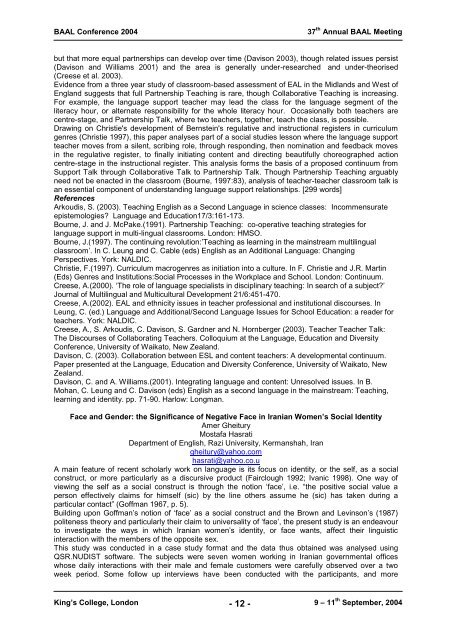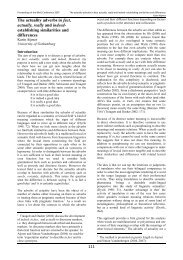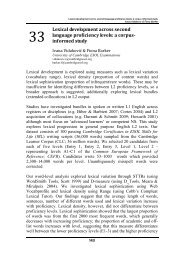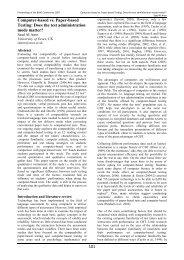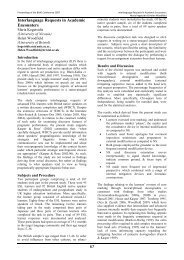Colloquia - British Association for Applied Linguistics
Colloquia - British Association for Applied Linguistics
Colloquia - British Association for Applied Linguistics
You also want an ePaper? Increase the reach of your titles
YUMPU automatically turns print PDFs into web optimized ePapers that Google loves.
BAAL Conference 2004 37 th Annual BAAL Meeting<br />
but that more equal partnerships can develop over time (Davison 2003), though related issues persist<br />
(Davison and Williams 2001) and the area is generally under-researched and under-theorised<br />
(Creese et al. 2003).<br />
Evidence from a three year study of classroom-based assessment of EAL in the Midlands and West of<br />
England suggests that full Partnership Teaching is rare, though Collaborative Teaching is increasing.<br />
For example, the language support teacher may lead the class <strong>for</strong> the language segment of the<br />
literacy hour, or alternate responsibility <strong>for</strong> the whole literacy hour. Occasionally both teachers are<br />
centre-stage, and Partnership Talk, where two teachers, together, teach the class, is possible.<br />
Drawing on Christie's development of Bernstein's regulative and instructional registers in curriculum<br />
genres (Christie 1997), this paper analyses part of a social studies lesson where the language support<br />
teacher moves from a silent, scribing role, through responding, then nomination and feedback moves<br />
in the regulative register, to finally initiating content and directing beautifully choreographed action<br />
centre-stage in the instructional register. This analysis <strong>for</strong>ms the basis of a proposed continuum from<br />
Support Talk through Collaborative Talk to Partnership Talk. Though Partnership Teaching arguably<br />
need not be enacted in the classroom (Bourne, 1997:83), analysis of teacher-teacher classroom talk is<br />
an essential component of understanding language support relationships. [299 words]<br />
References<br />
Arkoudis, S. (2003). Teaching English as a Second Language in science classes: Incommensurate<br />
epistemologies? Language and Education17/3:161-173.<br />
Bourne, J. and J. McPake.(1991). Partnership Teaching: co-operative teaching strategies <strong>for</strong><br />
language support in multi-lingual classrooms. London: HMSO.<br />
Bourne, J.(1997). The continuing revolution:‟Teaching as learning in the mainstream multilingual<br />
classroom‟. In C. Leung and C. Cable (eds) English as an Additional Language: Changing<br />
Perspectives. York: NALDIC.<br />
Christie, F.(1997). Curriculum macrogenres as initiation into a culture. In F. Christie and J.R. Martin<br />
(Eds) Genres and Institutions:Social Processes in the Workplace and School. London: Continuum.<br />
Creese, A.(2000). „The role of language specialists in disciplinary teaching: In search of a subject?‟<br />
Journal of Multilingual and Multicultural Development 21/6:451-470.<br />
Creese, A.(2002). EAL and ethnicity issues in teacher professional and institutional discourses. In<br />
Leung, C. (ed.) Language and Additional/Second Language Issues <strong>for</strong> School Education: a reader <strong>for</strong><br />
teachers. York: NALDIC.<br />
Creese, A., S. Arkoudis, C. Davison, S. Gardner and N. Hornberger (2003). Teacher Teacher Talk:<br />
The Discourses of Collaborating Teachers. Colloquium at the Language, Education and Diversity<br />
Conference, University of Waikato, New Zealand.<br />
Davison, C. (2003). Collaboration between ESL and content teachers: A developmental continuum.<br />
Paper presented at the Language, Education and Diversity Conference, University of Waikato, New<br />
Zealand.<br />
Davison, C. and A. Williams.(2001). Integrating language and content: Unresolved issues. In B.<br />
Mohan, C. Leung and C. Davison (eds) English as a second language in the mainstream: Teaching,<br />
learning and identity. pp. 71-90. Harlow: Longman.<br />
Face and Gender: the Significance of Negative Face in Iranian Women‟s Social Identity<br />
Amer Gheitury<br />
Mostafa Hasrati<br />
Department of English, Razi University, Kermanshah, Iran<br />
gheitury@yahoo.com<br />
hasrati@yahoo.co.u<br />
A main feature of recent scholarly work on language is its focus on identity, or the self, as a social<br />
construct, or more particularly as a discursive product (Fairclough 1992; Ivanic 1998). One way of<br />
viewing the self as a social construct is through the notion „face‟, i.e. “the positive social value a<br />
person effectively claims <strong>for</strong> himself (sic) by the line others assume he (sic) has taken during a<br />
particular contact” (Goffman 1967, p. 5).<br />
Building upon Goffman‟s notion of „face‟ as a social construct and the Brown and Levinson‟s (1987)<br />
politeness theory and particularly their claim to universality of „face‟, the present study is an endeavour<br />
to investigate the ways in which Iranian women‟s identity, or face wants, affect their linguistic<br />
interaction with the members of the opposite sex.<br />
This study was conducted in a case study <strong>for</strong>mat and the data thus obtained was analysed using<br />
QSR.NUDIST software. The subjects were seven women working in Iranian governmental offices<br />
whose daily interactions with their male and female customers were carefully observed over a two<br />
week period. Some follow up interviews have been conducted with the participants, and more<br />
King‟s College, London 9 – 11 th - 12 -<br />
September, 2004


